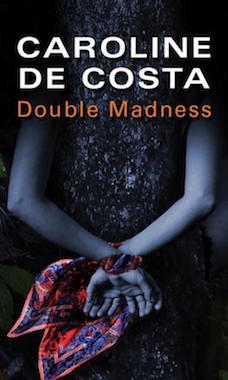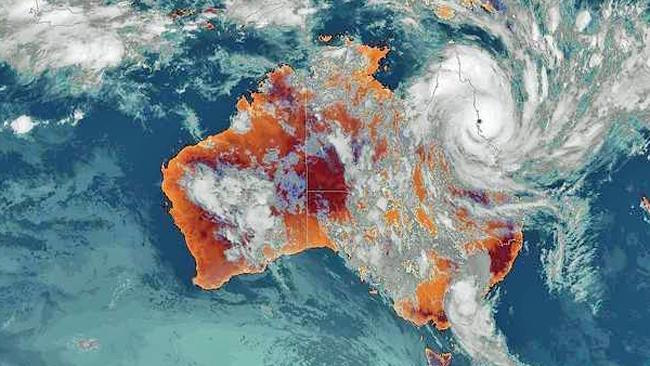Double Madness by Caroline de Costa
Published by Margaret River Press, 2015
If you like detective stories and a rollicking good read, with a nice dose of voyeurism thrown in, this first novel by Caroline de Costa, is definitely for you.
“Double Madness” is a crime novel set in far North Queensland. Not surprisingly, place is a very strong element throughout the novel, reflecting the beauty of this humid, lush area full of spectacular scenery.
A woman’s body is discovered tied to a tree with expensive silk scarves in the rainforest, several weeks after cyclone Yasi has devastated the region. It’s a mystery as to who the woman is and how she died. The main criminal investigation that follows is led by attractive indigenous detective, Cass Diamond, supported by her boss, Leslie Ferrando and other crime fighters.
 The theme of doctors being blackmailed enters in the second chapter, suggesting a motive for the woman’s murder, and the narrator is careful to portray the missing husband of Odile Janvier as probably not capable of carrying it out.
The theme of doctors being blackmailed enters in the second chapter, suggesting a motive for the woman’s murder, and the narrator is careful to portray the missing husband of Odile Janvier as probably not capable of carrying it out.
The irony and subtle humour underlying this novel is apparent early on through the author’s choice of names. The Latino names (Borgese and Ferrando) echo those of well-known male detectives in other novels, but the shining designation of “Cass Diamond” to the young female detective breaks the mould, as does the murdered woman’s name, “Odile Janvier”, that seems to suit her perfectly.
Straight, unisex Aussie names (Chris, Tim, Troy) offer an ironic contrast to the more exotic ones. There is also a subtle pairing and doubling of names, underscoring the theme of the book’s title, and emphasising difference, as well as Australia’s multicultural mix.
The third person narrative point-of-view closes in on particular characters, beginning in the early stages of the novel.
Vivid and relevant details make the main characters come alive, especially in the case of of Cass Diamond, whose “skin was the colour of almond peel”, and who had “cut her waist-length hair short, very short, so that now it sprang in curls from her head, black with red glints from her Irish grandmother”. The medical characters—the doctors, forensic specialists and the psychiatrist, whom we meet at intervals throughout—are all likeable in spite of, or perhaps because of, their eccentricity and flaws.
The novel, from the second chapter onwards, signals that it is to be a “one step forward and one step back” structure. This is reinforced by the use of the past perfect throughout the first chapter, at the beginning of the next chapter, and intermittently throughout the whole. The suspicion that Cass and the crime fighters are really on the backstep from the beginning is hard to dismiss. They are in the grip of a deep mystery: Who is it? How was she murdered? Irony, once again, in that the metaphor of the cyclone at the beginning, which carries all before it, leaving upheaval and devastation in its wake, is the opposite to this structural to-ing and fro-ing. At the midpoint onwards, the novel becomes slowed down by an overload of detail. And one gets the feeling that the body in the forest is a conceit for the author/narrator to reveal the events and characters of the fascinating individuals working in the medico/criminal scene up north. This, too, fits in with the ironic viewpoint. And like the novel itself, it is apt that the work is peopled with deliciously flawed characters, open to blackmail and to falling in love.
Cass’s first breakthrough occurs a quarter of the way through the novel, when she takes the Hermès scarves found on the woman’s wrists to the drycleaners, and discovers the murdered woman’s name. But it takes much longer for Odile Janvier’s identity, and that of her husband, Michel, to be discovered. It is only when the psychiatrist, Lyndall Symonds, enters into the investigation, that there are any real breakthroughs, which occur when she details the sexually sadomasochistic relationship of the Janvier couple.
The irony reaches fever point, two-thirds of the way through, when the blackmailed medicos’ sexual exploits have to be viewed by Cass and the team of investigators, with appropriate video equipment set up in separate cubicles: “Cass quickly found that it was one of the most unenjoyable tasks she’d ever been landed with in her whole time in the force and, listening to the exclamations of her colleagues in nearby cubicles, she gathered that they were not too happy either.”
The author is familiar with the medical, psychiatric and forensic fraternity where she lives and works as a lecturer in obstetrics; this shines through, appealing to the voyeur aspect in all of us. We may not care greatly for the unpleasant Odile, or for her husband, but we are led on a merry chase to seek the identity of the killer. On the way, our empathy is drawn towards the victims of the Controller, and their much more pleasant and sanguine relationships. These characters are portrayed vividly, often through clever dialogue. This is true even of the womanising Dr Trevor Symonds, who attends a medical conference in Hobart simply to earn points, and to contrive a meeting with a woman he’d had a secret, extramarital affair with: “In the photo Joy’s hair was streaked blonde, as it had been when he knew her. Her pubic hair was dark brown, though, he knew that, ha ha!”
The portrayal of Dr Mellish, a prudish, unlikely participant in sexual misconduct, yet a victim of Odile Janvier and the mysterious Controller, is hilarious, especially his dialogue dotted with sporting idioms: “Well, Jayasinghe, game, set and match, eh? Just close her up for me while I dictate some notes. Put in a drain. And I might have another cup of coffee while you open the batting on the gallbladder, eh?” Along with Cass Diamond, these characters provide a stark contrast to the horrific aspect—and horrible smell!—of the dead woman, described in detail at the start.
We empathise especially with the passionate Dr Henry Jolley and the delightful psychiatrist, Lyndall Symonds—she has taken years to divorce her unfaithful husband—who, along with Cass Diamond and her team of law defenders, all contribute to an enjoyable reading experience.
Romantic love affairs snowball in the last few chapters leading up the resolution, which comes at the very end, after a dramatic climax.


Great review, Anne! Can I get you to review my novel, when it’s published? Dina
That’s good. I can’t imagine it not being published, either. And the more controversy the better! Go girl go!